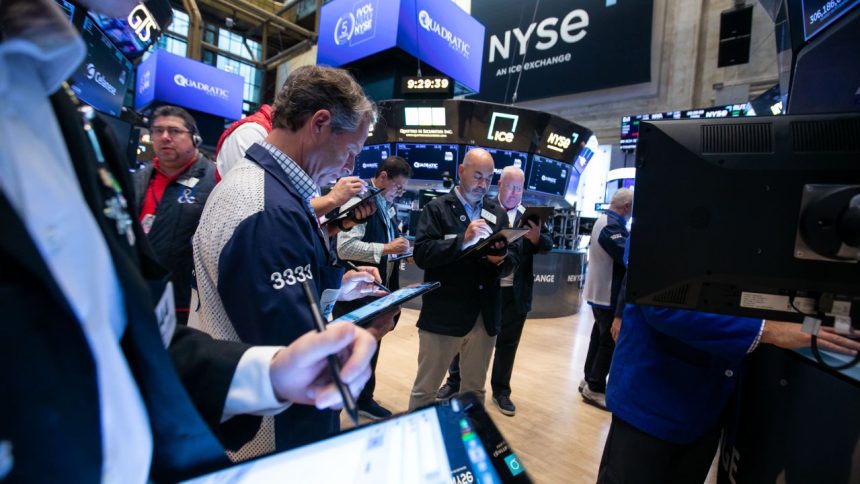The Russell 1000 stock index includes the largest and most successful publicly traded stocks in the U.S. The Russell 1000 is made up of about 1,000 stocks, making it one of the broadest measures of the stock market, and encompasses such bellwether stocks as Apple, Microsoft, Amazon and Alphabet.
Here are the details on the Russell 1000 index, which stocks are in it and a look at its historical returns.
What is the Russell 1000?
The Russell 1000 is a popular stock index that features around 1,000 of the largest stocks on U.S. exchanges, measured and weighted by their market capitalization, the total value of each company’s shares. The larger the company, the heavier its weighting in the overall index. The index represents about 93 percent of the total value of publicly traded U.S. stocks.
So the index features the mega-cap stocks such as Apple, Microsoft and Nvidia as well as large-cap stocks and even many mid-cap stocks. To gain entry to the Russell 1000, a company must meet special requirements, which are explained below.
It can be valuable for a company to be included in the index. When a company is selected, any investment funds tracking the index must buy the stock for their own portfolios. By adding more shares of the stock, they’ll tend to push up its price, while selling the stock that’s been booted out of the index. So, being included in the index helps push the stock price up and makes it easier to raise money.
The price of the Russell 1000 index is measured in points, not dollars, even though the stocks that comprise it are measured in dollars. The Russell 1000 price is the weighted average of all the components in the index. As the individual stocks rise and fall, the index follows, depending on exactly how the components are weighted.
The Russell 1000 is similar to other major stock indexes such as the well-known Dow Jones Industrial Average and the popular Standard & Poor’s 500 index, which tracks about 500 companies across all industries. The Nasdaq-100 is another similar index, and it includes the 100 largest non-financial stocks trading on the tech-heavy Nasdaq stock exchange.
The Russell 1000 index was created by FTSE Russell, part of the London Stock Exchange Group, and was launched Jan. 1, 1984.
Largest companies in the Russell 1000
These are the 10 largest companies in the Russell 1000 along with their total weighting in the index, as of June 12, 2024.
- Microsoft (MSFT) – 6.64 percent
- Apple (AAPL) – 6.28 percent
- NVIDIA (NVDA) – 6.02 percent
- Amazon (AMZN) – 3.41 percent
- Meta Platforms (META) – 2.28 percent
- Alphabet Class A (GOOGL) – 2.14 percent
- Alphabet Class C (GOOG) – 1.82 percent
- Berkshire Hathaway (BRK-B) – 1.51 percent
- Eli Lilly (LLY) – 1.48 percent
- Broadcom (AVGO) – 1.30 percent
In total, the 10 largest positions in the index comprise nearly 33 percent of the total value, which is a huge concentration in the top names, though it’s much less than in the Nasdaq-100 index and the S&P 500 index, where the largest stocks absolutely dominate the top holdings.
Alphabet appears twice in the list above because the company has multiple share classes, so each share class is given its own position based on its market capitalization.
How does a stock get added to the Russell 1000?
Each year, the Russell 1000 and the other Russell indexes are reconstituted. The annual Russell reconstitution, or rebalancing, happens each June, and sees the component stocks reweighted. Companies may be added or deleted from the index based on their market cap or other factors.
Key criteria for inclusion in a Russell index include:
- The company must be U.S.-based or have significant U.S. operations
- The stock must trade on a major U.S. exchange such as the New York Stock Exchange or Nasdaq
- The stock must be priced at at least $1 per share to be considered.
- Preferred stock and warrants are not considered.
- The market capitalization must be large enough to qualify the company for inclusion in the 1,000 largest stocks.
Other factors also play a role in a stock’s inclusion in the Russell 1000, including share availability, trading volume and company structure.
How the Russell 1000 index has performed over time
The Russell 1000 has delivered strong returns over time, making it an attractive investment. The index’s high weighting of the market’s best performers has led to some outstanding gains.
Here’s the index’s annualized returns to May 31, 2024.
| Time | 1 year | 3 years | 5 years | 10 years |
|---|---|---|---|---|
| Annualized return | 28.0% | 8.5% | 15.4% | 12.4% |
Source: FTSE Russell Factsheet
With this kind of strong long-term performance, it can make sense to just buy and hold a Russell 1000 index fund rather than trying to trade it short term. As an active investor, you’re prone to miss the big move up in the index, meaning that you’ll tend to underperform the index over time.
How to invest in the Russell 1000 index
Investors looking to invest in the Russell 1000 and enjoy its attractive returns have the option to invest in exchange-traded funds (ETFs) or mutual funds. Funds based on the Russell 1000 index will mirror the index’s performance, with only small deviations.
- iShares Russell 1000 ETF (IWB): This index ETF reflects the performance of the underlying index and charges a cheap expense ratio of just 0.15 percent.
- Vanguard Russell 1000 ETF (VONE): This index ETF from a low-cost leader tracks the full index at a low expense ratio of just 0.08 percent.
- iShares Russell 1000 Large-Cap Index Fund Investor A Shares (BRGAX): This index mutual fund charges a pricier 0.35 percent annually.
Besides these core funds, investors may purchase other index funds that slice and dice the index differently, weighting the stocks by growth and value, for example:
- iShares Russell 1000 Growth Index (IWF): This fund includes the stocks in the Russell 1000 Growth Index, a subset of the Russell 1000 index that includes higher-growth stocks. The fund charges a 0.19 percent expense ratio.
- iShares Russell 1000 Value Index (IWD): This fund includes the stocks in the Russell 1000 Value Index, a subset of the Russell 1000 index that includes lower-valuation stocks. The fund charges a 0.19 percent expense ratio.
What is the difference between the Russell 1000 and Russell 2000?
Russell has a number of indexes that chop up the market into various segments, typically depending on their market capitalization. Here are some of the most popular:
- Russell 1000 index: This index includes about 1,000 of the largest stocks trading on major U.S. exchanges.
- Russell 2000 index: The Russell 2000 index includes about 2,000 small-cap stocks trading on major U.S. exchanges.
- Russell 3000 index: The Russell 3000 index includes the stocks in both the Russell 1000 and the Russell 2000, and represents about 96 percent of the stock market’s total capitalization.
In addition, Russell has indexes that divide the market into other segments, including the Russell Top 50 Mega Cap, Russell Top 500, Russell Midcap and Russell Microcap, among others.
Bottom line
The Russell 1000 index is one of the most popular stock indexes, and it includes the vast majority of the total value of the U.S. stock market. Its high exposure to the fastest-growing stocks in the market means that it’s able to deliver strong returns to investors over time.
Editorial Disclaimer: All investors are advised to conduct their own independent research into investment strategies before making an investment decision. In addition, investors are advised that past investment product performance is no guarantee of future price appreciation.
Read the full article here
















